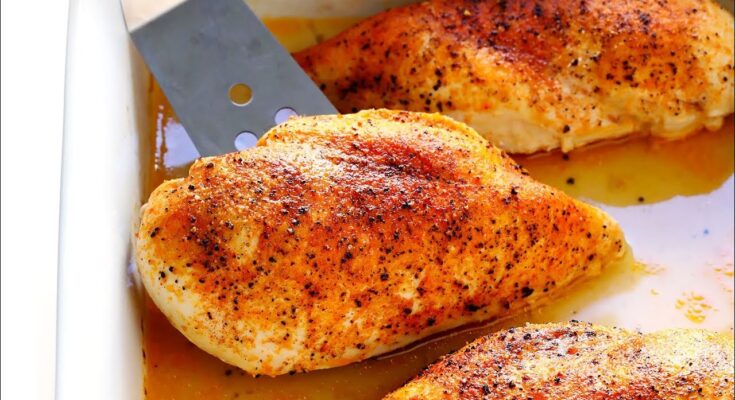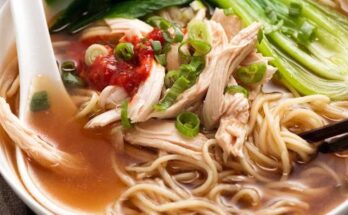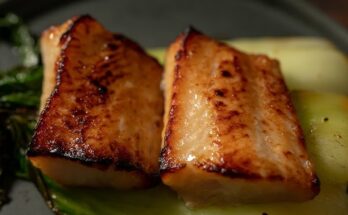Roast Chicken Breast Recipe: Roast chicken breast isn’t just a staple in countless kitchens—it’s the ultimate go-to meal for simplicity, flavor, and nutrition. If you’ve ever found yourself stuck between choosing a quick dinner and something healthy, this recipe solves both problems. Roasting chicken breast delivers a deliciously crisp outer layer while keeping the inside juicy and tender. It’s the kind of dish that feels like a warm hug on a plate.
Why is roasting so special? Unlike grilling, roasting allows the heat to circulate around the chicken, cooking it evenly without needing to flip or babysit the meat constantly. It locks in the juices while giving the surface that irresistible golden-brown color. Whether you’re cooking for one, prepping meals for the week, or serving dinner guests, roast chicken breast is an all-time crowd-pleaser.
And let’s be real—when you cook it right, that first juicy bite is unforgettable. Add to that the fact that it’s lean, packed with protein, and versatile enough to be seasoned a dozen different ways, and you’ve got yourself a winner.
Nutritional Benefits
One of the best things about chicken breast is its health profile. A 3.5 oz (100g) portion of skinless roasted chicken breast contains about:
- 165 calories
- 31g protein
- 3.6g fat
- 0g carbohydrates
It’s low in fat, high in protein, and completely carb-free, making it ideal for just about any diet—keto, paleo, low-carb, or just plain clean eating. Chicken breast is also a good source of B vitamins like niacin and B6, which support energy metabolism and brain health.
Plus, when you roast it instead of frying or heavily sautéing, you keep those nutritional benefits intact without adding excess oil or unnecessary calories. If you’re aiming for a meal that’s nutritious, satisfying, and easy to customize, this is it.
Ingredients You’ll Need
Main Ingredients
Let’s talk about what you really need to make a delicious roast chicken breast. You don’t need a fancy spice rack or a dozen rare ingredients. With just a few basics, you’ll get fantastic flavor.
Here are your must-haves:
- Boneless, skinless chicken breasts (about 6–8 oz per serving)
- Olive oil or melted butter (2–3 tablespoons)
- Salt (preferably kosher or sea salt)
- Freshly ground black pepper
- Garlic powder or fresh minced garlic
- Paprika (for color and subtle sweetness)
These form the foundation. Olive oil keeps things moist and helps the skin (if you’re using skin-on breasts) crisp up. Salt and pepper are non-negotiable, and the rest can be tailored based on your taste.
Optional Add-ins for Extra Flavor
Want to elevate things? Consider adding:
- Fresh herbs like thyme, rosemary, or oregano
- Lemon zest or juice for a citrus kick
- Onion powder
- Cayenne pepper or chili flakes for heat
- Honey or brown sugar for a slightly sweet crust
These ingredients add complexity and layers of flavor that turn your roasted chicken from everyday to extraordinary. Don’t be afraid to experiment—your taste buds will thank you.
Ingredient Substitutions
Don’t have something on hand? Here’s how you can swap:
- Butter instead of olive oil – gives a richer flavor
- Coconut oil – works great for a hint of tropical sweetness
- Dried herbs if you’re out of fresh ones (just use ⅓ the amount)
- Smoked paprika for a deeper, BBQ-like taste
These substitutions won’t ruin the dish—they’ll just tweak the flavor profile. That’s the beauty of roasting chicken breast: it’s adaptable and forgiving.
Essential Kitchen Tools and Equipment
Must-Have Tools
To make sure your chicken roasts perfectly, having the right tools can make a big difference:
- Oven – The most obvious one. Preheated to the right temperature is key.
- Baking sheet or roasting pan – Lined with foil or parchment for easy cleanup.
- Meat thermometer – Crucial for checking doneness (165°F is the magic number).
- Tongs – For handling the chicken without piercing it and letting out juices.
- Brush – To apply oil or butter evenly.
These basic tools make the process easier and cleaner, which is always a win when you’re in the kitchen.
Optional Tools for Enhanced Cooking
If you’re someone who loves to geek out on cooking gear:
- Wire rack – Placing chicken on a rack helps it cook evenly and not sit in its own juices.
- Cast iron skillet – Holds heat well and creates a beautiful sear before roasting.
- Aluminum foil tent – Useful if your chicken is browning too fast.
Not essential, but if you’ve got them, use them.
How to Prepare Your Workspace
Before you even preheat the oven, get your space in order:
- Clean your counters – It sounds basic, but it’s often skipped.
- Lay out all ingredients and tools – This helps you move quickly.
- Have a trash bowl or bag nearby – For trimmings and wrappers.
Organization makes the cooking process smoother and much more enjoyable. Less stress, better results.
Preparing the Chicken Breast
Cleaning and Trimming
Start with fresh chicken breast. Rinse briefly under cold water (this is debated—some prefer to skip rinsing for food safety reasons and just pat dry), then pat dry thoroughly with paper towels. Moisture on the surface prevents browning.
Next, inspect each piece. Trim off any visible fat or connective tissue. If the breast is very thick, consider butterflying it (slicing it in half horizontally) for more even cooking. You can also gently pound it to an even thickness using a meat mallet or the bottom of a heavy pan.
Brining or Marinating Options
Want next-level juiciness? Brine your chicken.
- Simple brine: ¼ cup salt to 4 cups water. Let the chicken soak for 30 minutes to 2 hours.
- Flavor brine: Add sugar, garlic, herbs, and lemon slices.
If you’re short on time, skip the brine and go for a quick marinade instead:
- Olive oil + lemon juice + herbs + garlic – Marinate for 30 minutes to 1 hour.
Either method adds moisture and flavor, helping you avoid dry or bland chicken.
Seasoning Tips and Techniques
Now for the fun part: seasoning. Use a generous hand—chicken breast is mild and loves bold flavors.
Start by brushing both sides with olive oil or melted butter. Then season with salt, pepper, garlic powder, paprika, and any herbs you’re using. Make sure to coat evenly, pressing seasoning gently into the surface.
Want ultra-flavorful chicken? Season under the breast (if using skin-on) too. That way, the flavor soaks in as it roasts.
Step-by-Step Guide to Roasting Chicken Breast
Step 1: Preheating and Preparing the Oven
Start by preheating your oven to 400°F (200°C). While it heats up, pat the chicken breasts dry with paper towels—this helps them roast beautifully instead of steaming. Rub them with olive oil, salt, pepper, and your favorite seasonings like garlic powder, paprika, or herbs. The oil locks in moisture and gives the chicken that irresistible golden crust.
Step 2: Arranging the Chicken on the Pan
Place the seasoned chicken breasts on a lightly greased baking sheet or in a roasting dish. Arrange them so they aren’t touching—air circulation is key for even cooking. You can also add sliced onions, lemon wedges, or herbs around the chicken for extra flavor and aroma.
Step 3: Roasting the Chicken Breast
Transfer the pan to the preheated oven and roast for 20–25 minutes, depending on the size of the chicken breasts. Avoid overcooking—nothing ruins a good roast like dry chicken. Keep an eye on it toward the end for that perfect golden-brown finish.
Step 4: Checking for Doneness
Use a meat thermometer to check the internal temperature; it should reach 165°F (74°C) at the thickest part. If you don’t have a thermometer, pierce the meat—if the juices run clear, it’s ready.
Step 5: Resting and Serving
Once roasted, remove the chicken from the oven and let it rest for 5–10 minutes before slicing. This allows the juices to redistribute, keeping every bite tender and juicy. Serve warm with roasted veggies, salad, or mashed potatoes—simple, satisfying, and timelessly delicious.
Tips for Juicy and Flavorful Chicken
Internal Temperature Tips
One of the key elements to roasting a moist chicken breast is mastering temperature control. As mentioned earlier, 165°F (74°C) is the safe internal temperature recommended by the USDA. But here’s the trick: pull it just before it hits that number and let it finish cooking while resting.
If you don’t already own an instant-read meat thermometer, now’s the time. It takes the guesswork out and saves you from overcooking.
If you’re cooking multiple pieces, check the largest and thickest one. If it’s done, the rest should be, too.
How to Avoid Dryness
Dry chicken happens when you either overcook it or skip prepping properly. Here are top tricks to prevent that:
- Brine or marinate – Even a 30-minute soak can do wonders.
- Use fat – A drizzle of olive oil or butter adds richness and moisture.
- Roast at high heat – It seals the outside fast, trapping juices inside.
- Let it rest – Always. Even if you’re hungry and in a rush.
Another smart move? Don’t keep opening the oven to check it. Every time you open that door, you lose heat and mess with the cooking process. Trust the timer and use your thermometer instead.
Seasoning Suggestions
If you want to break out of the basic salt-and-pepper routine, here are some delicious seasoning blends to try:
- Italian-style: Oregano, thyme, basil, garlic, lemon zest
- Cajun rub: Paprika, cayenne, garlic powder, onion powder, thyme
- Moroccan mix: Cumin, coriander, cinnamon, paprika, turmeric
- Lemon pepper: Zested lemon + cracked black pepper
Don’t be afraid to go bold. Chicken breast is a blank canvas—it takes on flavors like a champ.
Serving Suggestions
Side Dishes That Pair Well
So, you’ve got your perfectly roasted chicken breast—now what? Time to build a plate that’s just as tasty as the main event. Whether you’re going for a light lunch or a hearty dinner, the sides can make or break the meal.
Here are some classic and creative options that pair beautifully with roast chicken:
- Roasted Vegetables: Think carrots, zucchini, bell peppers, or Brussels sprouts tossed in olive oil, garlic, and herbs.
- Mashed Potatoes: Creamy, buttery, and smooth—perfect for soaking up those juicy chicken drippings.
- Rice Pilaf or Wild Rice: Add some toasted almonds, cranberries, or herbs for flair.
- Steamed Green Beans or Broccoli: Simple, nutritious, and delicious with a sprinkle of sea salt and lemon zest.
- Garden Salad: Crisp greens, cucumbers, cherry tomatoes, and a vinaigrette bring freshness to your plate.
- Grain Bowls: Mix quinoa or farro with chickpeas, cucumber, feta, and a drizzle of olive oil for a Mediterranean-inspired combo.
You can also serve your roasted chicken over pasta tossed in olive oil and garlic, or stuff it into wraps, pitas, or sandwiches. The options are endless.
Plating Tips for a Gourmet Look
Want to impress dinner guests or make your Instagram followers drool? Presentation matters. Here’s how to plate like a pro:
- Slice diagonally for a clean, elegant look.
- Fan out the slices on a bed of greens or grains.
- Add color with herbs, edible flowers, or vibrant veggies.
- Drizzle sauces sparingly over the top for that gourmet touch.
A simple sprig of rosemary or a lemon wedge can elevate the visual appeal of your dish dramatically. Make it look as good as it tastes!
Quick Meal Ideas with Leftovers
Leftover roasted chicken is pure gold when it comes to meal prep. You can make:
- Chicken salad sandwiches: Mix with mayo, mustard, celery, and herbs.
- Tacos or wraps: Add avocado, slaw, and your favorite hot sauce.
- Stir-fry: Toss into a pan with veggies, soy sauce, and rice.
- Soup or chili: Shred and throw into your favorite broth or bean stew.
- Pasta dishes: Mix with cream sauce or tomato sauce and your favorite noodles.
Roasted chicken breast is like the gift that keeps on giving—flavorful, versatile, and ready to make your weeknight cooking a breeze.
Common Mistakes to Avoid
Overcooking
This is probably the number one mistake people make when roasting chicken breast. The fear of undercooked chicken leads to overcompensating—and the result is dry, rubbery meat. The solution?
- Use a meat thermometer.
- Know your oven (some run hotter or cooler than the dial says).
- Trust the timing and don’t overthink it.
Another trick: remove the chicken a few degrees below 165°F and let carryover cooking do the rest.
Underseasoning
Chicken breast is a lean, neutral-tasting meat. It needs seasoning. If you’re not generous with salt, herbs, and spices, you’ll end up with something bland—even if it’s cooked perfectly.
Don’t be shy with:
- Salt and pepper
- Garlic and herbs
- Spices like paprika, cumin, or chili powder
- Citrus zest or juice for brightness
If you’re unsure, taste your seasoning mix before applying it. You can even rub a bit onto a piece of bread and toast it to see how it tastes.
Skipping the Rest Time
We’ve said it before, and we’ll say it again: do not skip the rest time. Cutting into your chicken breast right out of the oven is like popping a balloon—everything good inside will come gushing out.
That 5–10 minutes of patience makes all the difference between juicy and dry. Let it rest, then slice. You’ll thank yourself every time.
Variations on the Classic Roast
Spicy Herb Roasted Chicken Breast
Want something bold and zesty? This variation packs flavor and a little heat:
- Rub: Olive oil, garlic, chili flakes, paprika, cayenne, fresh thyme, and lemon zest.
- Let marinate for 1 hour.
- Roast as usual, and finish with a squeeze of lime.
This version pairs great with rice, roasted sweet potatoes, or a cooling cucumber salad to balance the spice.
Mediterranean Style
This version is light, herbaceous, and bursting with flavor. It’s perfect for meal prep or a healthy dinner:
- Rub: Olive oil, oregano, garlic, lemon juice, and chopped parsley.
- Add kalamata olives and cherry tomatoes to the pan for extra flair.
- Serve with couscous, tzatziki, or a Greek salad.
Drizzle with a touch of balsamic glaze before serving for that final flavor boost.
Garlic Butter Infused
Craving something richer? Go for garlic butter:
- Butter mix: Melted butter, minced garlic, parsley, a pinch of salt.
- Brush it over the chicken before roasting, and again halfway through cooking.
- Serve with mashed potatoes or a creamy pasta for comfort food heaven.
You can even add a sprinkle of grated parmesan before roasting to create a crispy, cheesy crust.
Storing and Reheating Tips
Best Storage Methods
Store leftover roast chicken breast properly, and it’ll stay moist and flavorful for days. Let the chicken cool completely before storing.
- Use airtight containers to keep the moisture in.
- Separate layers with parchment if stacking.
- Keep in the fridge for up to 4 days.
For longer storage, freeze it:
- Wrap tightly in foil or plastic wrap.
- Place in a freezer bag or vacuum-sealed pouch.
- Label with the date, and use within 3 months for best quality.
Reheating Without Losing Moisture
Chicken breast dries out easily when reheated, but with the right method, you can keep it juicy:
Oven (best for flavor and texture):
- Preheat to 325°F (160°C).
- Add a splash of broth or water.
- Cover loosely with foil.
- Heat for 10–15 minutes.
Stovetop (fast option):
- Slice and sauté gently with a bit of oil or butter.
Microwave (quickest, but watch closely):
- Use 50% power.
- Cover with a damp paper towel.
- Reheat in 30-second bursts.
Always check to make sure it’s heated through to 165°F internally.
Freezing Guidelines
If you’re meal prepping or just want to keep some chicken on hand, freezing is a great option.
- Freeze whole breasts or sliced portions.
- Store in single-serving bags for easy defrosting.
- Thaw overnight in the fridge, not on the counter.
When done right, reheated frozen chicken can be just as delicious as the day it was roasted.
FAQs about Roast Chicken Breast Recipe
1. What herbs go best with roast chicken breast?
Thyme, rosemary, parsley, oregano, basil, and tarragon all pair wonderfully. Use fresh for more vibrant flavor or dried for convenience.
2. Can I roast chicken breasts with the skin on?
Absolutely. Skin-on breasts will be juicier and have a crispy, flavorful layer. Just adjust your seasoning and cooking time slightly.
3. How do I prevent my chicken from sticking to the pan?
Use parchment paper, foil, or a light layer of oil. A non-stick roasting rack also helps.
4. Can I use a dry rub instead of a marinade?
Yes! Dry rubs are perfect for building flavor. Just apply generously and let sit for 15–30 minutes before roasting.
5. What sauces go well with roasted chicken breast?
Try lemon herb, garlic butter, creamy mustard, BBQ, or chimichurri for an added punch of flavor.
Conclusion
Roasting chicken breast might seem simple—and it is—but doing it well? That’s where the magic happens. With the right prep, seasoning, and attention to temperature, you can turn a plain piece of meat into something downright mouthwatering.
Whether you’re serving it fresh from the oven, slicing it into a salad, or tucking it into tacos, roasted chicken breast is a culinary blank slate just waiting for your flavor inspiration. Keep experimenting, keep tasting, and don’t be afraid to get creative. After all, the best dishes come from a blend of good technique and personal flair.



